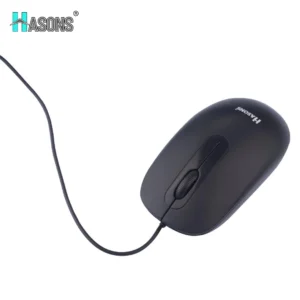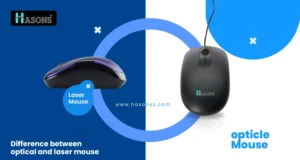Optical Mouse – What is Optical Mouse
An optical mouse is a computer mouse that uses a light source, typically a light-emitting diode (LED), and a light detector, such as a CMOS sensor, to detect movement instead of the traditional rolling ball mechanism. The name comes from the use of optical sensors to detect motion.
How Optical Mice Work
Optical mice work by using the light source to continuously illuminate the surface underneath the mouse. The light detector then sees changes in the reflection as the mouse moves, allowing the optical mouse to track movement.
The LED light shines down through a small hole onto the desk or mouse pad surface. The light reflects off the surface and bounces back up through another hole into the light detector. As the mouse moves, the angle of the light reflection changes, which is picked up by the light detector. Circuitry in the mouse translates these changes into the mouse cursor movement on screen.
Most optical mice today use a small red LED light source and a CMOS sensor chip to detect movement. The LED shines light down onto the surface, while the CMOS sensor captures multiple images per second of the surface pattern. By comparing these images and seeing how the pattern changes, the optical mouse chip can detect which direction, how far and how fast the mouse is moving.

Advantages of Optical Mouse
Optical mice have several advantages over older mechanical mice:
- No Moving Parts: Without a rolling ball or moving components, optical mice have fewer breakable pieces and are more reliable and durable over time.
- Enhanced Tracking: The latest optical sensors provide very precise tracking with no skip or jump in the cursor movement. Newer gaming optical mice have very high DPI ratings of 8,000 to 16,000.
- Work on More Surfaces: While ball mice require a special mouse pad, optical mice work on most tabletop and desk surfaces, even glass. This makes them much more versatile.
- Easier Maintenance: There are no mouse balls to clean or mouse pads to maintain. Optical mice avoid issues with dirt, dust and oil buildup.
Disadvantages of Optical Mouse
While very capable, optical mice also come with some disadvantages compared to other mouse technologies:
- Surface Dependent: While they work on most surfaces, some transparent, reflective or changing surfaces can confuse the optical tracking. Black mouse pads can also cause issues.
- LED Power: The LED light, while efficient, still requires a power source and adds slightly to the mouse power consumption. New gaming mice are moving to more efficient laser tracking to overcome this.
- Higher Cost: Basic optical mice cost slightly more than old ball mice. However, prices have come down steadily over the years.
Hasons MultiTask Master
Wired Computer MouseRs. 270.00Shop Now!
Difference Between Optical and Laser Mice
The other popular modern mouse tracking technology is the laser mouse. So what is the difference between optical and laser mice?

- Light Source: Optical mice use an LED light source, while laser mice use invisible, infrared vertical cavity surface emitting lasers (VCSELs).
- Precision: Laser mice can reliably reach higher DPI ratings from 8,200 up to 20,000 DPI for very precise tracking. Top optical gaming mice range from 1,600 to 12,000 DPI.
- Surface Use: Laser mice work on more surfaces including glass and reflective materials that give optical mice problems.
- Power Use: The laser VCSEL diodes in laser mice consume more power, reducing battery life in wireless models.
- Cost: Laser mice are generally more expensive than similar optical mice, though prices vary considerably.
For most average users and gaming, optical and laser mice performance is quite comparable. Laser mice provide better precision and surface tracking while optical mice tend to be more affordable.
Uses of Optical Mice
Thanks to their tracking precision, durability and versatility, optical mice are the most widely used pointing device on desktop and laptop PCs. Some common applications include:
- General Computer Use: Optical mice excel at everyday desktop computer use, including operating systems navigation, document editing, web browsing, multimedia and more. They provide excellent control and usability.
- Gaming: Optical gaming mice are very popular for PC gaming thanks to customizable DPI settings, ergonomic designs for long play sessions and precise tracking and cursor control.
- Laptop and Notebook Use: Almost all laptop and mobile PCs today use small form factor optical tracking mice in lieu of the old trackstick pointing devices. Optical mice make using laptops much easier.
- Graphic Design: For digital design, photo and video editing, optical mice allow precise image and timeline navigation as well as manipulation using design software. High DPI optical models shine here.
- 3D Modeling and CAD: Newer optical gaming mice make rotating, panning and zooming 3D models or CAD engineering diagrams smooth and effortless. The high cursor speed is essential.
- Office Use: Basic optical mice included with desktop PCs see widespread office use for document creation, presentations, spreadsheets, company database access and other business applications. They’re simple to use while being highly functional pointing devices.
Conclusion
Since first hitting the market in 1980, the computer mouse has evolved considerably. The optical mouse has become the standard, providing smooth, precise cursor control for everything from office work to intense gaming sessions. Optical tracking gives mice better speed, accuracy and versatility over older mechanical mice.
With no moving parts, optical mice also see enhancements in reliability and usability over ball mice. And optical technology continues advancing. Higher resolution sensors enable finer movement detection for activities like graphics work. Wireless and Bluetooth optical mice free users from cable constraints. And gaming-centric optical mice allow tuning of sensitivity and acceleration for different playing styles or game genres.
For the average user, optical mice deliver excellent control and comfort in desktop PC use. And innovations like higher quality optical sensors raise the bar in specialized applications like gaming and design. Optical mouse technology has clearly overtaken older mechanical approaches. And continuous improvements will ensure optical mice stay at the forefront of desktop pointing and input.
| If you are reading Optical Mouse then also check our other blogs: | |
| Characteristics of cloud computing | Device Management In Operating System |
| Importance of Internet of Things (IoT) | Tree Topology in Computer Networks |
Optical Mouse
- What is the difference between a mouse and an optical mouse?A standard mouse uses a rolling ball on the underside to detect movement and track cursor movement on screen. An optical mouse uses an LED light source and light detector to optically sense mouse movement without any moving parts.
- What is optical and non optical mouse?An optical mouse uses a light source like a light-emitting diode (LED) and a light sensor to optically detect motion as you move the mouse. A non-optical mouse, like a mechanical mouse, uses a rolling ball and sensors to mechanically detect movement instead.
- Which optical mouse is best?Some top optical mice options include:
- Logitech G502 Hero: Highly popular optical gaming mouse with tunable weights and up to 16,000 DPI sensor.
- Razer DeathAdder V2: Ergonomic right-handed design optical mouse great for gaming.
- Logitech MX Master 3: Wireless optical mouse with cross-computer control and ergonomic shape.
- Apple Magic Mouse 2: Innovative touch-sensitive optical mouse for Macs.
- What is the other name of optical mouse?An optical mouse is also sometimes referred to as a:
- LED mouse
- Optical LED mouse
- Photodiode mouse
- CMOS mouse
- What is optical mouse and its uses?An optical mouse works by shining LED light onto the mousing surface and using an image sensor to optically detect surface pattern changes as the mouse moves. This optical tracking technology allows it to precisely translate mouse movement into cursor movement on screen. Optical mice see wide use for:
- General computer navigation
- Office work
- Gaming
- Graphic design
- 3D modeling
- Laptop and mobile use
- Multimedia editing
